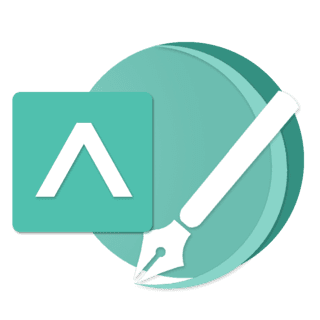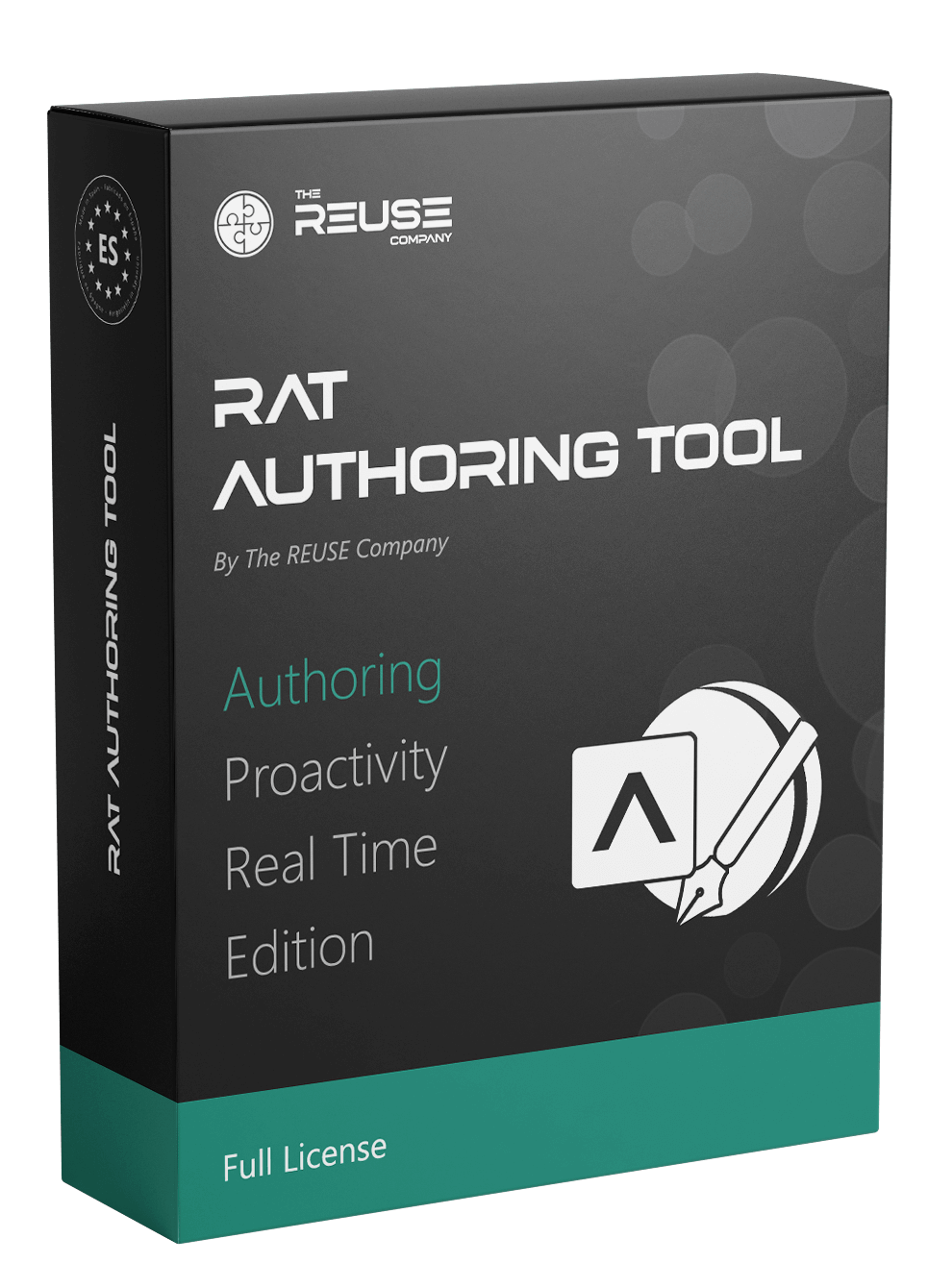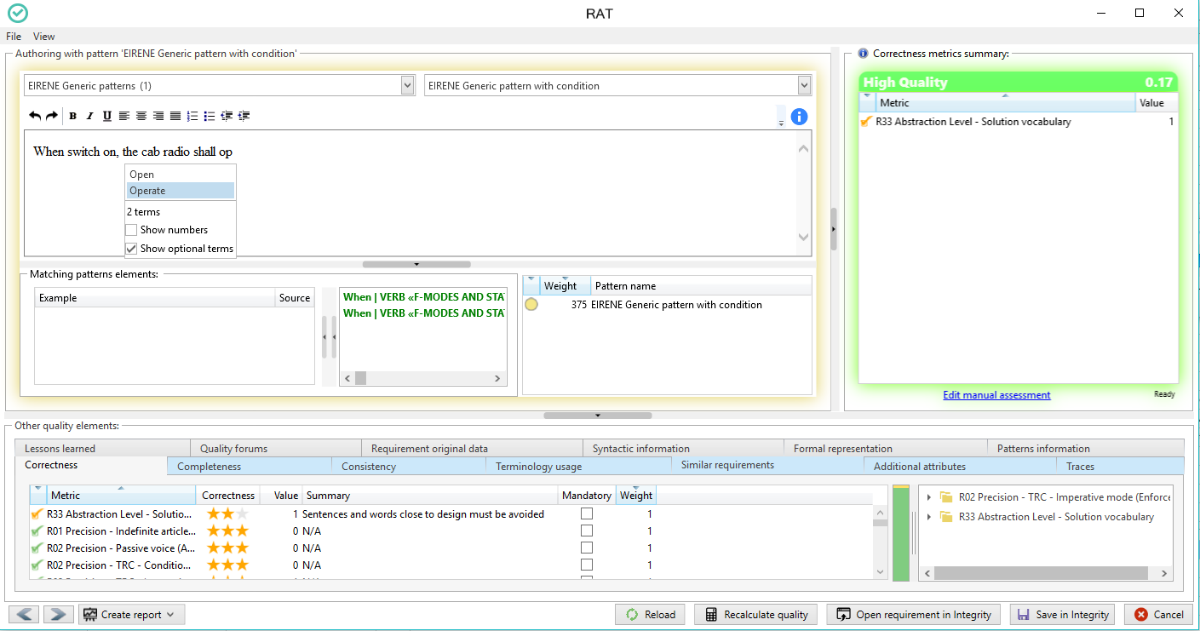RAT - AUTHORING Tools - requirements and models writing
A SMARTer Way to Author Engineering Items

Documents, models, and requirements authoring
While traversing the System Life Cycle, engineers produce thousands of engineering items. Most of them are abstract work products (requirements, models, architectures, test cases, manuals, risks, etc.) defined to achieve a system and its components.
RAT – AUTHORING Tool is the ideal way to help engineers create different types of artifacts. It helps authors during the demanding process of writing requirement specifications or other documents. This way the overall quality of the projects improve.
RAT – AUTHORING Tool is the perfect assistant for system analysts/ engineers when writing the system documentation or creating models. RAT leads engineers with agreed-upon patterns, suggests the most suitable content for each piece of written information, and always ensures correct syntax. The tool also provides real-time quality checking of the items being created. The result is that RAT frees engineers from format concerns (e.g. requirements structure) allowing them to focus on engineering decisions. The engineers and RAT team up to improve the overall quality of your projects.

Benefits of RAT – AUTHORING Tool
The most important benefits of RAT – AUTHORING Tool when writing any text are:
Quality
RAT – AUTHORING Tool provides real-time quality guidelines when writing requirements, documents, or texts inside models. Best practices, checklists, or rules, such as the INCOSE Guide to Writing Requirements or the EARS patterns, are now closer to system engineers.
Time
RAT – AUTHORING Tool helps you save time. “Get it right the first time” can now be applied to requirements, test cases, and other documents and texts. RAT reduces the verification loops at different levels (Stakeholder, System, subsystem, component).
Money
RAT – AUTHORING Tools save money. Focusing on text and requirements quality from the beginning helps reduce rework and subsequent costs.
Features of RAT - AUTHORING Tool
The different features of RAT – AUTHORING Tool will help you write high-quality requirements, documents, and all kinds of texts.
Real-time quality checking
Based on the catalog of rules and metrics established (INCOSE, NASA, ECSS, etc.), RAT will check the quality of the requirements in real time.
Requirements patterns
Choose a pattern for your requirements from a preset library of patterns (EARS patterns, Sophist, ECSS, etc.). Then follow the different slots comprising a well-formed requirement of the selected type (Functional, Non-Functional, Safety…).
Connect to a controlled vocabulary
The vocabulary can be managed either in KM – KNOWLEDGE Manager or using the concepts established in your models.
Consistency check
RAT will ensure, in real time, that your requirement is consistent with the other requirements in the same document, in other documents, or even with your models.
Detection of overlapped requirements
The semantic engine will make RAT identify similar requirements to avoid contradictory or redundant statements in your specification.
Correctness, Consistency and Completeness (CCC)
Once a pattern has been selected, RAT – AUTHORING Tool shows its structure, description, and examples of how it should be used. You just select the right terms and semantics from a controlled vocabulary suggested while typing. The pattern ensures that the requirement, or any other text, follows the right syntax and provides the proper information.
RAT implements a smart way of writing, a technique that guides the author. This provides an accurate way of creating consistent requirements and speeds up system documentation writing.
Applying the CCC methodology to requirements engineering provides several benefits:
- Both humans and computers will read and understand textual artifacts more easily without ambiguity (Correctness).
- The chances of writing redundant or contradictory content are decreased (Consistency).
- The user gets help from the whole range of ontology inputs to enhance the coverage of functional and non-functional aspects of the specification (Completeness)
- Homogeneous vocabulary and grammar across multiple documents improve the overall quality of the written specification (Requirement patterns).
- A smart Search Engine “understands” the information stated in the specification (Reuse and Semantic formalization).
The information reported by RAT – AUTHORING Tool includes out-of-the-box quality metrics for detecting inconsistency, ambiguity, and duplicated items. Both the real-time quality assessment and the intelligent writing assistant, are included as plug-ins on top of the major tools. Thus, you can take advantage of the features of RAT – AUTHORING Tools for requirements management, risk or test case management, modeling tools, simulation tools, etc.
Measure the quality of requirements, models and artifacts in real time
RAT – AUTHORING Tool provides real-time quality analysis and highlights defects in the requirement. This reduces the time needed for manual quality inspection, peer review, and double-checking while boosting the quality of engineering items.
RAT notifies the user, in real time, about the lack of consistency between the currently edited requirement or model and others in the same document or project. It alos notifies the user about lack of consistency between different types of engineering items.
Customization
RAT – AUTHORING Tool uses a customizable set of textual patterns, which can be easily tailored and managed using the KM – KNOWLEDGE Manager.
RAT uses a customizable set of quality metrics, which can be easily tailored and managed using the RQA – QUALITY Studio.
RAT users can benefit from an easy-to-use feature to suggest new patterns or suggest changes to existing ones. The tool notifies the knowledge architect, who may accept or reject suggested changes to the Knowledge Base. This feature is available in the KM – KNOWLEDGE Manager capability.
Requirements authoring within models
When RAT – AUTHORING Tool is used inside a modeling tool, e.g., Capella its advantages increase. You can:
- Write requirements following the name conventions of the different model elements
- Generate links automatically between model elements and requirements
- Synchronize the requirements with your preferred Requirements Management tool.
Automatic import and export between different supported environments
RAT – AUTHORING Tool provides a round-trip mechanism that allows a seamless transfer of engineering items to various tools. You can interoperate between different sources of information, e.g. requirements and models. The tool implements new OSLC specifications enabling the exchange of information regardless of its format or the tools used to create it.
Connectivity and Integration
RAT – AUTHORING Tool, as a capability inside SES ENGINEERING Studio, can be connected to a broad range of Systems Engineering tools. SES ENGINEERING Studio connects Requirements Management tools, ALMs, PLMs, and MBSE tools and makes them interoperate. You can also develop your own connectors to RAT using our API.
50+ Connectors
There are more than 50 connectors available for RAT – AUTHORING Tool. They are detailed on the SES ENGINEERING Studio page.
Add-in version
Besides, RAT – AUTHORING Tool is also available as a fully integrated add-in to some of the major Systems Engineering tools: IBM Rational DOORS, PTC Windchill, Capella MBSE, IBM Rhapsody, or MS Office.
RAT – AUTHORING Tool web version
RAT – AUTHORING Tool is available as a web browser extension, compatible with MS Edge, Google Chrome and Mozilla Firefox.
This extends the integration to web-based ALM and PLM platforms, such as SIEMENS Polarion & Teamcenter, Codebeamer, JIRA, Atlassian Confluence, etc.

